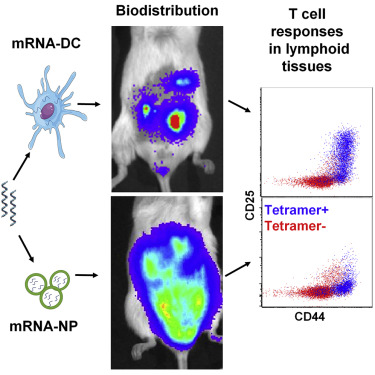当前位置:
X-MOL 学术
›
Mol. Ther. Methods Clin. Dev.
›
论文详情
Our official English website, www.x-mol.net, welcomes your
feedback! (Note: you will need to create a separate account there.)
Nanoparticles versus Dendritic Cells as Vehicles to Deliver mRNA Encoding Multiple Epitopes for Immunotherapy.
Molecular Therapy - Methods & Clinical Development ( IF 4.6 ) Pub Date : 2019-11-11 , DOI: 10.1016/j.omtm.2019.10.015 Rebuma Firdessa-Fite 1 , Rémi J Creusot 1
Molecular Therapy - Methods & Clinical Development ( IF 4.6 ) Pub Date : 2019-11-11 , DOI: 10.1016/j.omtm.2019.10.015 Rebuma Firdessa-Fite 1 , Rémi J Creusot 1
Affiliation

|
The efficacy of antigen-specific immunotherapy relies heavily on efficient antigen delivery to antigen-presenting cells and engagement of as many disease-relevant T cells as possible in various lymphoid tissues, which are challenging to achieve. Here, we compared two approaches to deliver mRNA encoding multiple epitopes targeting both CD4+ and CD8+ T cells: a lipid-based nanoparticle platform to target endogenous antigen-presenting cells in vivo versus ex vivo mRNA-electroporated dendritic cells. After intraperitoneal injection, the nanoparticle platform facilitated efficient entry of mRNA into various endogenous antigen-presenting cells, including lymph node stromal cells, and elicited robust T cell responses within a wider network of lymphoid tissues compared with dendritic cells. Following intravenous injection, mRNA-electroporated dendritic cells and the nanoparticle platform localized primarily in lung and spleen, respectively. When administered locally via an intradermal route, both platforms resulted in mRNA expression at the injection site and in robust T cell responses in draining lymph nodes. This study indicates that multiple epitopes, customizable for specific patient populations and encoded by mRNA, can be targeted to different lymphoid tissues based on delivery vehicle and route, and constitute the groundwork for future studies using mRNA to reprogram exogenous or endogenous APCs for immunotherapy.
中文翻译:

纳米颗粒与树突状细胞作为提供编码多个表位的 mRNA 用于免疫治疗的载体。
抗原特异性免疫疗法的功效在很大程度上依赖于抗原向抗原呈递细胞的有效递送以及尽可能多的与疾病相关的 T 细胞在各种淋巴组织中的参与,这很难实现。在这里,我们比较了两种递送 mRNA 编码靶向 CD4+ 和 CD8+ T 细胞的多个表位的方法:一种基于脂质的纳米颗粒平台,用于靶向体内内源性抗原呈递细胞与体外 mRNA 电穿孔树突细胞。腹膜内注射后,纳米颗粒平台促进 mRNA 有效进入各种内源性抗原呈递细胞,包括淋巴结基质细胞,并在比树突状细胞更广泛的淋巴组织网络内引发强烈的 T 细胞反应。静脉注射后,mRNA 电穿孔树突状细胞和纳米颗粒平台分别主要位于肺和脾脏。当通过皮内途径局部给药时,两种平台都导致注射部位的 mRNA 表达和引流淋巴结中强烈的 T 细胞反应。该研究表明,可针对特定患者群体定制并由 mRNA 编码的多个表位,可以根据递送载体和途径靶向不同的淋巴组织,并为未来使用 mRNA 重新编程外源性或内源性 APC 以进行免疫治疗的研究奠定基础。这两个平台都导致了注射部位的 mRNA 表达和引流淋巴结中强烈的 T 细胞反应。该研究表明,可针对特定患者群体定制并由 mRNA 编码的多个表位,可以根据递送载体和途径靶向不同的淋巴组织,并为未来使用 mRNA 重新编程外源性或内源性 APC 以进行免疫治疗的研究奠定基础。这两个平台都导致了注射部位的 mRNA 表达和引流淋巴结中强烈的 T 细胞反应。该研究表明,可针对特定患者群体定制并由 mRNA 编码的多个表位,可以根据递送载体和途径靶向不同的淋巴组织,并为未来使用 mRNA 重新编程外源性或内源性 APC 以进行免疫治疗的研究奠定基础。
更新日期:2019-11-11
中文翻译:

纳米颗粒与树突状细胞作为提供编码多个表位的 mRNA 用于免疫治疗的载体。
抗原特异性免疫疗法的功效在很大程度上依赖于抗原向抗原呈递细胞的有效递送以及尽可能多的与疾病相关的 T 细胞在各种淋巴组织中的参与,这很难实现。在这里,我们比较了两种递送 mRNA 编码靶向 CD4+ 和 CD8+ T 细胞的多个表位的方法:一种基于脂质的纳米颗粒平台,用于靶向体内内源性抗原呈递细胞与体外 mRNA 电穿孔树突细胞。腹膜内注射后,纳米颗粒平台促进 mRNA 有效进入各种内源性抗原呈递细胞,包括淋巴结基质细胞,并在比树突状细胞更广泛的淋巴组织网络内引发强烈的 T 细胞反应。静脉注射后,mRNA 电穿孔树突状细胞和纳米颗粒平台分别主要位于肺和脾脏。当通过皮内途径局部给药时,两种平台都导致注射部位的 mRNA 表达和引流淋巴结中强烈的 T 细胞反应。该研究表明,可针对特定患者群体定制并由 mRNA 编码的多个表位,可以根据递送载体和途径靶向不同的淋巴组织,并为未来使用 mRNA 重新编程外源性或内源性 APC 以进行免疫治疗的研究奠定基础。这两个平台都导致了注射部位的 mRNA 表达和引流淋巴结中强烈的 T 细胞反应。该研究表明,可针对特定患者群体定制并由 mRNA 编码的多个表位,可以根据递送载体和途径靶向不同的淋巴组织,并为未来使用 mRNA 重新编程外源性或内源性 APC 以进行免疫治疗的研究奠定基础。这两个平台都导致了注射部位的 mRNA 表达和引流淋巴结中强烈的 T 细胞反应。该研究表明,可针对特定患者群体定制并由 mRNA 编码的多个表位,可以根据递送载体和途径靶向不同的淋巴组织,并为未来使用 mRNA 重新编程外源性或内源性 APC 以进行免疫治疗的研究奠定基础。











































 京公网安备 11010802027423号
京公网安备 11010802027423号